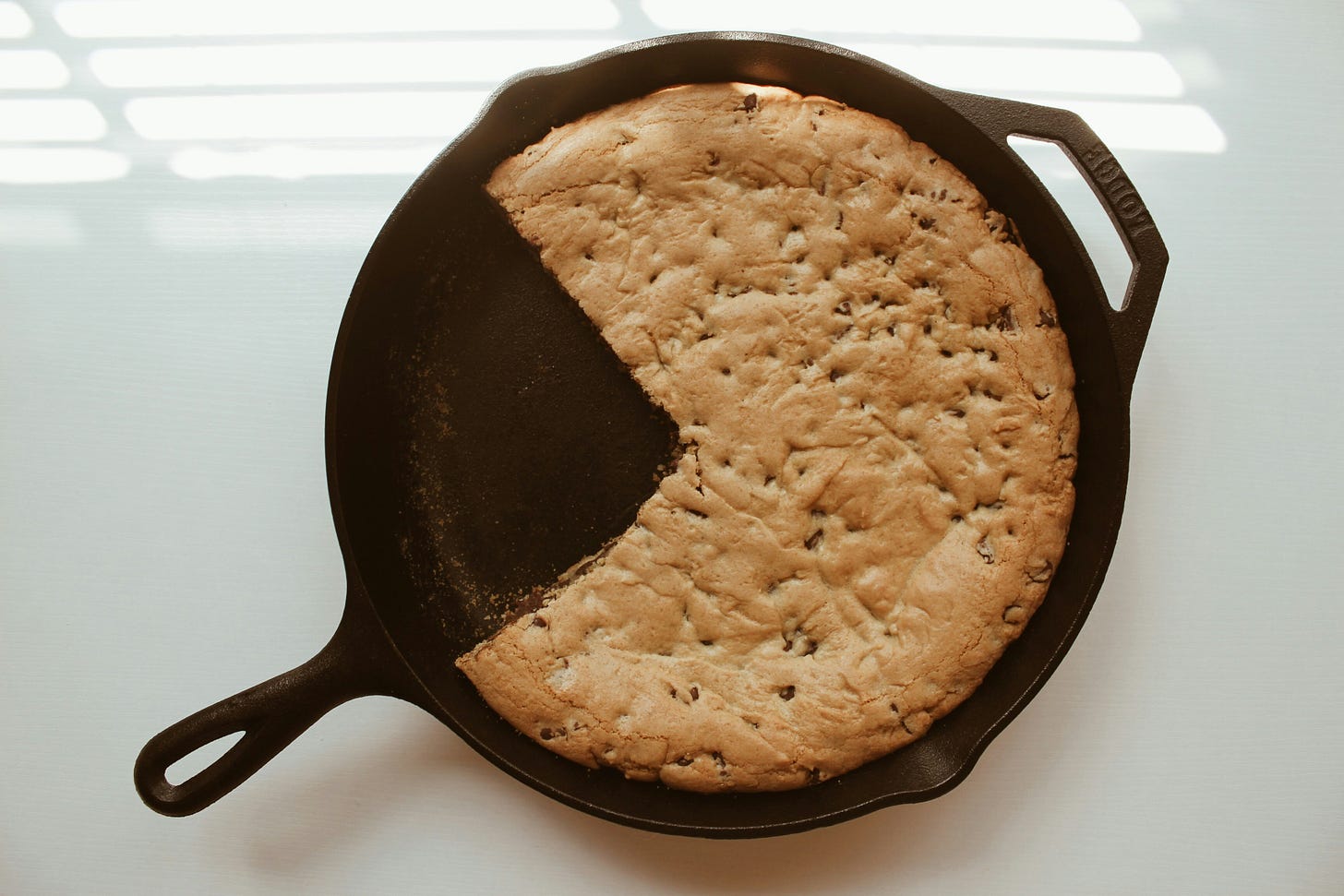This article is part of the Dish-Covery series, where we uncover the stories behind your beloved flavors. Pulling back the curtain to look at culinary traditions that shape our modern palates.

Very few recipes have captured American hearts, taste buds, and imaginations like the Toll House cookie. Originating from an accidental creation in a small Massachusetts inn, this iconic cookie became a ubiquitous symbol of comfort, nostalgia, and the “purity” of homemade foods. This Dish-Covery delves into the rich history, cultural impact, and mythology surrounding the original Toll House cookie recipe, tracing its journey from serendipitous discovery to a beloved classic.
Toll House Cookie Originations
The story of the Toll House cookie begins in the 1930s, at the Toll House Inn in Whitman, Massachusetts. Owned by Ruth Wakefield and her husband, the inn quickly gained a reputation for its hospitality and delicious meals. Ruth is often credited as the chocolate chip cookie pioneer, earning her the affectionate title of "mother of the chocolate chip cookie." However, the history of the chocolate chip cookie remains shrouded by various theories and interpretations.
The exact date of the cookie's invention is also a topic of contention, with conflicting sources citing different years ranging from 1930 to 1940. Despite diligent research by food historians and enthusiasts alike, pinning down a definitive date has proven challenging due to inconsistencies in historical records and cookbook editions. Furthermore, discrepancies surround the origins of the Toll House Inn itself, with conflicting information regarding its construction date and historical significance.
One prevailing theory suggests that Ruth developed the recipe while experimenting with a traditional “Butter Drop Do” cookie recipe. There are, however, conflicting accounts regarding the source of Ms. Wakefield's inspiration, with some asserting that she derived her recipe from an old sugar cookie recipe rather than a butter cookie one. In an interview with the Boston Herald-American in 1974, Ruth is quoted as saying, “We had been serving a thin butterscotch nut cookie with ice cream. Everybody seemed to love it, but I was trying to give them something different” with the difference being the addition of bits - or chips - of chocolate.
In that vein, another version of the story suggests that Ruth ran out of baking chocolate and substituted a bar of Nestle's chocolate in its place. According to this story, while Baker's Chocolate melted and integrated with the dough during baking, Nestle's chocolate retained its shape, yielding distinct chocolate chips in the cookies.
A separate account proposes that Nestle chocolate bars “accidentally fell” into the cookie dough and were subsequently broken into chips by an electric mixer. However, the plausibility of this scenario is so incredible that you simply have to admire the ingenuity of the invention. Any seasoned cook would remove the chocolate bars to salvage the batch.
In truth, the likely story behind the creation of the chocolate chip cookie remains elusive, with no consensus among historians and culinary experts, except perhaps the consensus that the cookie is delicious.
Popular Culture and the Cookie
Whatever the truth of its origin, The Toll House chocolate chip cookie quickly gained popularity among inn guests and locals alike, becoming a beloved staple of the inn's menu. As Nestlé's semi-sweet chocolate became known as the key ingredient, the company struck a deal with Wakefield to print her recipe on the back of their chocolate chip packaging, a practice that continues today.
The Toll House cookie's cultural impact extends much further than I imagine that anyone could dream. Today, the cookie holds a special place in American culinary tradition, with generations of families passing down recipe variations and baking techniques from one kitchen to the next. From school bake sales to holiday gatherings, the Toll House cookie is a beloved treat that brings people together in mutual admiration.
In popular culture, the Toll House cookie has been immortalized in literature, film, and television. It has inspired countless adaptations and variations, from giant skillet cookies to ice cream sandwiches. The recipe has been featured in cookbooks, commercials, and even a postage stamp, cementing its status as an American classic. The Toll House cookie has also become a symbol of ingenuity and resourcefulness, reminding us that sometimes the best discoveries are made by accident.
The Woman Behind the Cookie
Ruth was born in East Walpole, Massachusetts on June 17th, 1903. Following her graduation in 1924, Ruth embarked on a career journey, teaching home economics at Brockton High School alongside roles as a hospital dietitian and a customer service representative at a utility company. In 1928, Ruth married Kenneth Donald Wakefield, a meat packing executive. With their two children, the family decided in 1930 to acquire a historic building in Whitman, Plymouth County - a building reputed to have served as a toll house as early as 1709. They transformed it into a lodge aptly named the Toll House Inn. Ruth's culinary talents quickly garnered attention, propelling the inn's dining capacity from a modest seven tables to a flourishing sixty.
Ruth’s kitchen blended her original recipes with cherished family heirlooms passed down from her grandmother, and these homey and delicious dishes proved to be an instant hit, prompting an expansion of the inn's dining area to accommodate the growing influx of patrons.
In 1931, she released a cookbook titled "Ruth Wakefield's Tried and True Recipes," and following the success of her cookie recipe, Ruth published the "Toll House Tried and True Recipes" cookbook in 1939, which featured her famous chocolate chip cookie recipe. This cookbook became a cherished culinary resource for home cooks across America and further solidified Ruth's reputation as a pioneer in the kitchen.
Ruth Wakefield remained involved in the culinary world, sharing her expertise and love for cooking with others. She continued to run the Toll House Inn until 1966, when she retired and sold the inn. The historic building burned down in 1984.
Ruth Wakefield passed away in 1977 at 73, leaving behind a legacy that inspires bakers and food enthusiasts worldwide. Her invention of the chocolate chip cookie forever changed the landscape of American desserts.
More Dish-Cover Articles
Here are some more stories about audacious women and their contributions to culinary history.
Food on the Radio
American food history and culture has no shortage of fictional characters who want to influence your grocery purchases (Miss Chiquita, The Kool-Aid Man, Ronald McDonald) or even the way that we approach 20th Century cooking (Betty Crocker, Pillsbury Dough Boy. While some made their debut in magazines and in-store advertising, others rode into our home k…
Tempests in the Tea Room
In a battle that spanned seven decades, women working towards the right to vote faced pressure and criticism from all corners - even from other women. One of the greatest critiques was that granting women voting rights would cause home lives to suffer. While some suffragists favored a bold, militant style, others took up more quiet, persuasive means to …
Ladies Who Lunch
As we spend the month of March in contemplation about women’s history, let’s consider the tuna salad sandwich. We know it as the stalwart champion of the humble brown bag lunch, but it has a deeper history as the result of women entering the workforce in the early 20th Century. Let’s take a brief sojourn together through the history of the sandwich and …

Let’s Stay Connected
Follow us on Instagram @asweeat,
Join our Family Recipes, Traditions, and Food Lore community on Facebook
Subscribe to the As We Eat Journal
Listen to the As We Eat Podcast
Do you have a great idea 💡 for a show topic, a recipe 🥘 that you want to share, or just say “hi”👋🏻? Send us an email at connect@asweeat.com
Looking for a unique gift idea for a birthday, anniversary, holiday, host or hostess, or just because? Consider giving a subscription to the As We Eat Journal.




















This was a delightful read! Thanks you for sharing. I've been making Toll House cookies since I was a wee sprout. In fact, in the 1970s, when my single mom was struggling, I set up a Tv tray on Fairfax boulevard in Los Angeles and would sell them to try to earn a little extra money. I've been making a vegan version that is as delicious. I substitute soy butter, Egg Replacer (which is made from potato starch and sold at Whole Foods), and I use dark chocolate chips. They are so delicious and I've had friends tell me they prefer them to the dairy version. Go figure.
I definitely need to check out that cookbook !